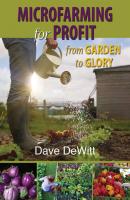Microfarming for Profit. Dave DeWitt
Чтение книги онлайн.

Читать онлайн книгу Microfarming for Profit - Dave DeWitt страница
Название: Microfarming for Profit
Автор: Dave DeWitt
Издательство: Ingram
Жанр: Сад и Огород
isbn: 9781937226404
isbn:
First Torrey House Press Edition, January 2015
Copyright © 2015 by Dave DeWitt
All rights reserved. No part of this book may be reproduced or retransmitted in any form or by any means without the written consent of the publisher.
Published by Torrey House Press, LLC
Salt Lake City, Utah
e-Book ISBN: 978-1-937226-40-4
Library of Congress Control Number: 2014939594
Author photo by Sergio Salvador
Cover and interior design by Lois Manno
Selected Books by Dave DeWitt
The Pepper Garden
Peppers of the World
The Complete Chile Pepper Book
The Southwest Table
Dishing Up New Mexico
Too Many Chiles
CONTENTS
Introduction: The Great Terrarium
Part 1: Planning Your Microfarm
Part 2: Fourteen Featured Microfarmers and One Big Buyer
Part 3: My Microfarms
Part 4: Building Your Microfarm
Part 5: How to Sell, Market, and Advertise Your Microfarm
Afterword
Suggested Reading
Index
Thanks to everyone who assisted with this project: Marlin Bensinger, Mary Jane Wilan, Gillie Augeri, Leo Lascaux, Matt Yohalem, Ethan Diness, Kathi Caldwell, Lorenzo Candelaria, Hans Wressnig, all the microfarmers profiled or mentioned, and my long-time agent, Scott Mendel.
In 2013, I built my fourth microfarm, and that’s one of the microfarms profiled in Part 4 of this book. My first was in Richmond, Virginia, when my wife at the time decided she wanted to open a retail, boutique plant shop in the trendy section of town called the Fan District. Terrariums were all the rage around 1970, and my wife wanted to take advantage of the craze. Like the gift baskets of today, she wanted to build the terrariums and sell them to people as gift items or decorations for homes. But first we had a whole lot to learn.
I was already a knowledgeable gardener—my parents had taken good care of that education. But neither my wife nor I knew much about houseplants, aside from the commonest ones. If we were going to sell houseplants in any form, we had to learn as much as possible about them. We soon came to realize that buying plants wholesale and selling them retail was only part of the solution. Raising our own plants in greenhouses from seeds or cuttings was a much better idea, so that’s what we did. I didn’t call it a microfarm, but it was because I was growing plants for money, not as a hobby. After six months of planning, studying, building a makeshift greenhouse, and growing most of the plants we could sell, my wife had the grand opening of The Great Terrarium. Of course, I produced the radio commercials for it, and business was brisk.
The shop was successful and profitable, but after a year, one big problem emerged: my wife didn’t like being a retailer. She had to work weekends and late nights during sales. It was difficult to find good help, and even though she made money, she was not happy. So after one year, when the lease was up, she closed the business, paid all the bills, and went back to the profession she studied in college: interior design.
Forty-three years later, I’m still growing plants for money, but I don’t depend on it for survival. It’s just a hobby gone nuts, and it’s mostly about chile peppers, which are my specialty, and interacting with the New Mexico food community, of which I am very much a part. Over the years, I’ve developed techniques to produce the highest possible yields. For the most part, I use organic methods but I’m not one hundred percent organic. I subscribe to the same philosophy as the late Dick Thompson, who was one of the founders of Practical Farmers of Iowa and practiced what he called “a more balanced farming system.” He was one of the “beacons of sustainable agriculture,” according to food expert Mark Bittman. He was not an organic farmer, but a practical one. He occasionally used herbicides when they were necessary, and I do too, but not directly in my microfarm. I use them only when weeds first sprout away from the microfarmed area so my yard will not be overwhelmed by fast-growing Russian thistles, commonly called tumbleweeds.
Thompson also assisted his compost by using chemical fertilizers. I do too, but only for the plants in pots with restricted roots. Otherwise they would have very low yields. I happen to believe that if the plant needs nitrogen, it doesn’t matter how that element is applied. Plants in pots need a much higher amount than plants fertilized with manure that have much larger root systems, and a water-soluble source does an excellent job of fertilizer application. I do not use insecticides but rather inspect the plants closely using mechanical means, like directed streams of water and insect traps, to remove the pests. I handpick the tomato hornworms off my plants and feed them to the robins.
Dick Thompson and his wife had such a productive farm compared to his neighbors’ monocultural farms with tons of chemicals, that from the mid ‘80s to his death in 2013, he and his wife showed more than forty thousand visitors how a relatively small farm could support a small family by respecting and caring for the land. His soil had twice the amount of organic material as his neighbors’ and his farm yielded between $150 and $200 more per acre than the others. He didn’t have a microfarm, but three hundred acres, which these days is called a small farm. Microfarmers would call it huge.
Mark Bittman, writing in the Opinionator column of The New York Times, wrote that Dick Thompson “tried СКАЧАТЬ